 The Sewing Lawyer has been using the same wallet, on and off, since 1984. That's a lot of years for a little leather object. I know I bought it in 1984, because I remember doing so very shortly after my arrival in Cambridge, UK, where I spent a glorious year as a graduate student. I think it was very inexpensive - £5 sticks in my mind.
The Sewing Lawyer has been using the same wallet, on and off, since 1984. That's a lot of years for a little leather object. I know I bought it in 1984, because I remember doing so very shortly after my arrival in Cambridge, UK, where I spent a glorious year as a graduate student. I think it was very inexpensive - £5 sticks in my mind. 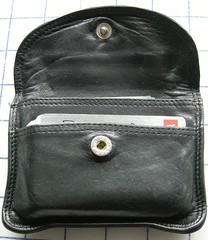
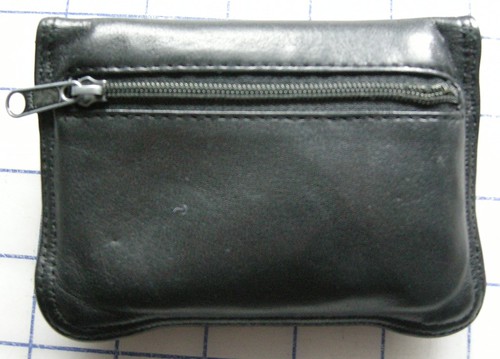 I thought it was pretty nice when I bought it, but I probably didn't come to appreciate how great a thing it is until I had used it for a while. It's a really simple but effective design and it's extraordinarily well made. If I had known that the leather of that wallet would stay so glossy and beautiful through moderately intensive use for more than a quarter century (ULP!), I probably would have sprung for a few of them even on my student budget. And now, if it was only a question of wear to the leather, I wouldn't consider abandoning my old friend. Unfortunately, however, the coil zipper of the coin compartment, at back, is about to give out.
I thought it was pretty nice when I bought it, but I probably didn't come to appreciate how great a thing it is until I had used it for a while. It's a really simple but effective design and it's extraordinarily well made. If I had known that the leather of that wallet would stay so glossy and beautiful through moderately intensive use for more than a quarter century (ULP!), I probably would have sprung for a few of them even on my student budget. And now, if it was only a question of wear to the leather, I wouldn't consider abandoning my old friend. Unfortunately, however, the coil zipper of the coin compartment, at back, is about to give out. Really, the thing only has two flaws (aside from the fact that the zipper only lasted for a couple million openings and closings).
First, it's a small black object that tends to lurk in the deep recesses of a black-lined handbag. The Sewing Lawyer was a graduate student in 1984. Those of you who are her contemporaries will find that enough has been said. Those of you who are younger ... well, let me just say that the day will come when you too will curse the designer who chose black fabric for the lining of your handbag.
The second flaw is probably the reason that the zipper won't be lasting into its fourth decade. The coin compartment opening doesn't open up very much, really. Over time, a lot of stress has been put on the coils at the closed end where the pull is repeatedly forced (a couple million times so far) as far open as it will go, when the Sewing Lawyer's not-really very big fingers probe the innards of the wallet to find the correct change.
So thoughts turned to producing a comparable object, but without the two flaws, to replace the original. The first problem was to get the right kind of leather. When I visited Perfect Leather in Toronto last fall, I showed the knowledgeable lady at the desk my wallet and asked her what kind of leather it was made from. Without missing a beat, she said "Goat .... what colour do you want?" There was quite an array. I came away with a couple of square feet of orange goat leather. I used some of it to make a case for my reading glasses (not all of those were presents), which is extremely easy to find in my handbag.
I approached the design and manufacture of the orange clone as an experiment, on the "just do it" approach to sewing. So it's definitely not perfect. I may make a second one that will look and perform slightly better, but for now, I'll happily use my new wallet.
This pic reveals two problems. First, the edges were too thick for my machine so I abandoned my original complete clone plan and didn't do the double row of topstiching on the original (yes, the original was sewn right sides together and turned, just as my clone is). I had to rip out the stitches around the flap, leaving unsightly holes (sigh). I would have to figure out how to remove a lot more bulk from the edges if I am going to replicate the original in this respect.
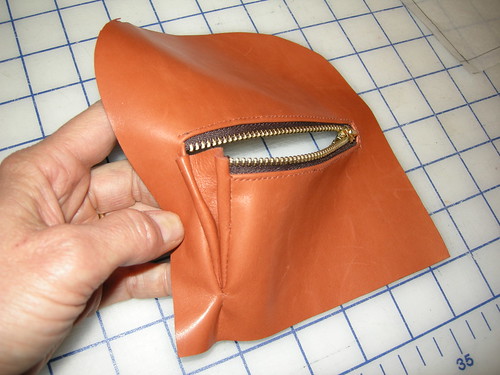 Second, I forgot to cut the outer layer of the leather flap longer than the under layer to allow for turn of the "cloth", so the seam tends to flip up in a not-great-looking way. This would be easy to remedy. Next time. And I think the flap is a slightly less attractive shape than the original, even though I made the pattern by tracing around it. This would also be an easy fix. Next time.
Second, I forgot to cut the outer layer of the leather flap longer than the under layer to allow for turn of the "cloth", so the seam tends to flip up in a not-great-looking way. This would be easy to remedy. Next time. And I think the flap is a slightly less attractive shape than the original, even though I made the pattern by tracing around it. This would also be an easy fix. Next time. Anyhow, but for these problems which I might be able to remedy, the construction of this little project was super simple. It has two layers - the inner layer with two pockets and the outer layer with the zipper opening.
Anyhow, but for these problems which I might be able to remedy, the construction of this little project was super simple. It has two layers - the inner layer with two pockets and the outer layer with the zipper opening. Construct each layer. Above you can see my functional but not beautiful gusset to remedy the second flaw. I found a metal zipper which should be stronger. To the left, proof that I realized I needed to build in turn of "cloth" room in the pockets, even though I stupidly forgot to do the same for the flap.
Apply the snap. Seriously, this was the part that took the longest, since it has been many years since I've used any of these four-part snap assemblies of which I seemingly still have hundreds in my stash. (Cleverly, the snap is attached in such a way that it absolutely does not matter if the usually-visible part matches the leather - my snap is green. Can you tell?)
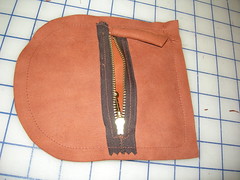
Sew the layers together around the edges, right sides together. Trim seam allowances. Turn it right side out through the zipper opening.
Done (except for my abortive attempt at topstitching).
The gusset works rather well.
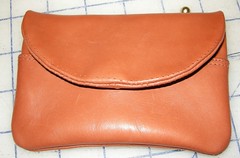


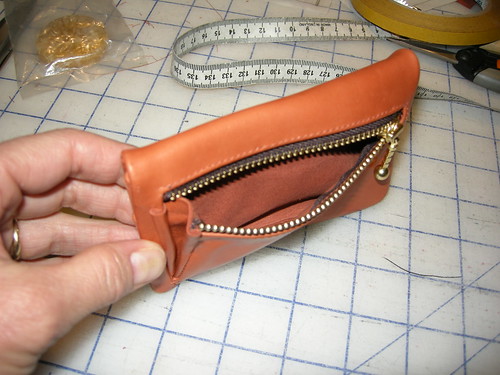



I like it! The second one should be just right.
ReplyDeleteGosh, I had the exact same purse (wallet) in a gorgeous dark olive green, which after many years of use I searched in vain to replace. I would never have thought of making my own! They were made by Tula, and one of my former workmates had a sister who married the man who started the Tula company, before it was bought up by a bigger concern. I still have a red Tula keypurse bought at the same time, which is shabby beyond belief but which I keep because I love it so much.
ReplyDeleteThe amount of Canadian coins we accumulate daily was perhaps the demise of your original wallet... :/
ReplyDeleteVery pretty new addition!
Rhonda
I sure hope you have enough of that gorgeous orange stuff to make no2 :-). I've fairly recently acquired a black bag with bright orange lining with that stated visibility purpose, and it helps a lot. But an orange wallet is a fine alternative.
ReplyDeleteSad when a beloved and much-used object bites the bullet like this, eh? But good for you to go so far towards replacing it!
Very nice work. I am so impressed when I see projects such as these. "see a need-->develop a design--->make" wow!
ReplyDeleteI wonder if hammering the seams pre-sewing, like you do with multiple thicknesses of leather would help at all? I have also use rubber cement glue between thicknesses of leather to keep it in place while sewing.
ReplyDeleteI have some scraps of leather around and have made a few small zipper cases of them, but have never been able to get the corners right. Maybe I should take my own hammering advice!
That's a fun project! And what a neat wallet design, very compact and practical. I like the orange colour of your new one, like you said it's much easier to find in the dark!
ReplyDeleteI greatly admire your wallet. The colour is gorgeous.I especially like the use of the longer pull on the zipper.
ReplyDeletewow I think this is great - I have a red leather wallet I bought in Italy years ago that is barely hanging on, I handstitched it several places where the sewing unraveled after only 20 years ha ha.
ReplyDeleteI like the orange. you have inspired me to give this a try.
My, my, your are launch in leather sewing... you are so amazing Kay !
ReplyDeleteHi Kay - I love your pants; I have been looking for good wallet pattern. I live literally two blocks from Tandy Leather - I am inspired by your posts. BTW, I gave you the Stylish Blogger Award. . . cause you're awesome:) Pam
ReplyDeleteThis is SO inspiring! My wallet is only about 10 years old 0 can't justify replacing it for awhile, but when I do, I'll remember your inspiration!
ReplyDeleteIt's totally awesome that you are making your own wallet! Totally!
ReplyDeleteleather is so addictive! good to see that you caught the bug!
ReplyDeleteI've thought of reproducing a wallet, but not actually tried, so I admire your actually doing so! As far as the folded piece of the coin pocket, would it work to just have the gusset(?) piece have the raw edges to the outside? And use a lapped seam on the inner edge? That way there would be much less bulk. I think there's a finish you can get to put on the raw edges to either camoflage or accent as you'd like.
ReplyDeleteSearch "skiving leather"
ReplyDelete